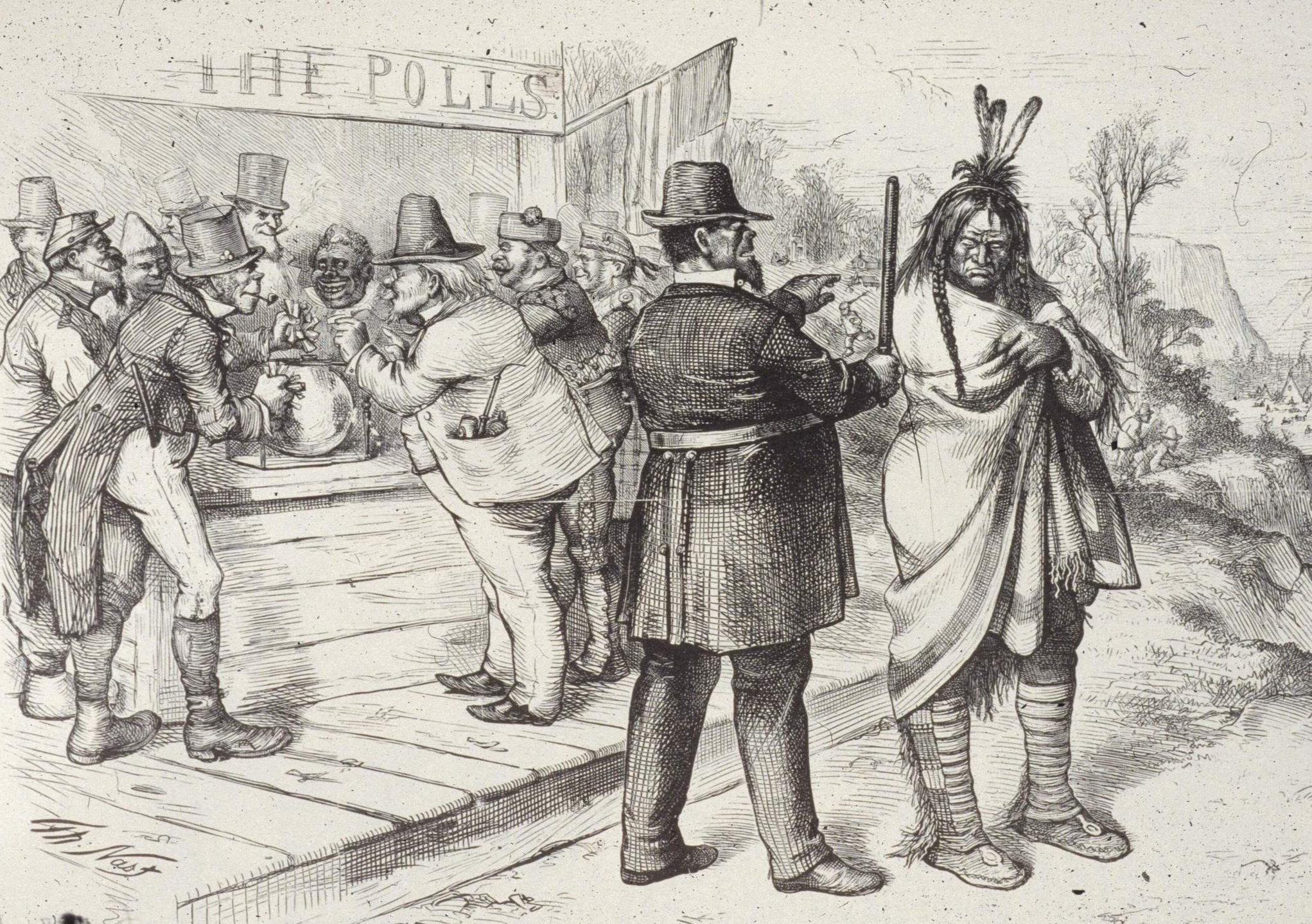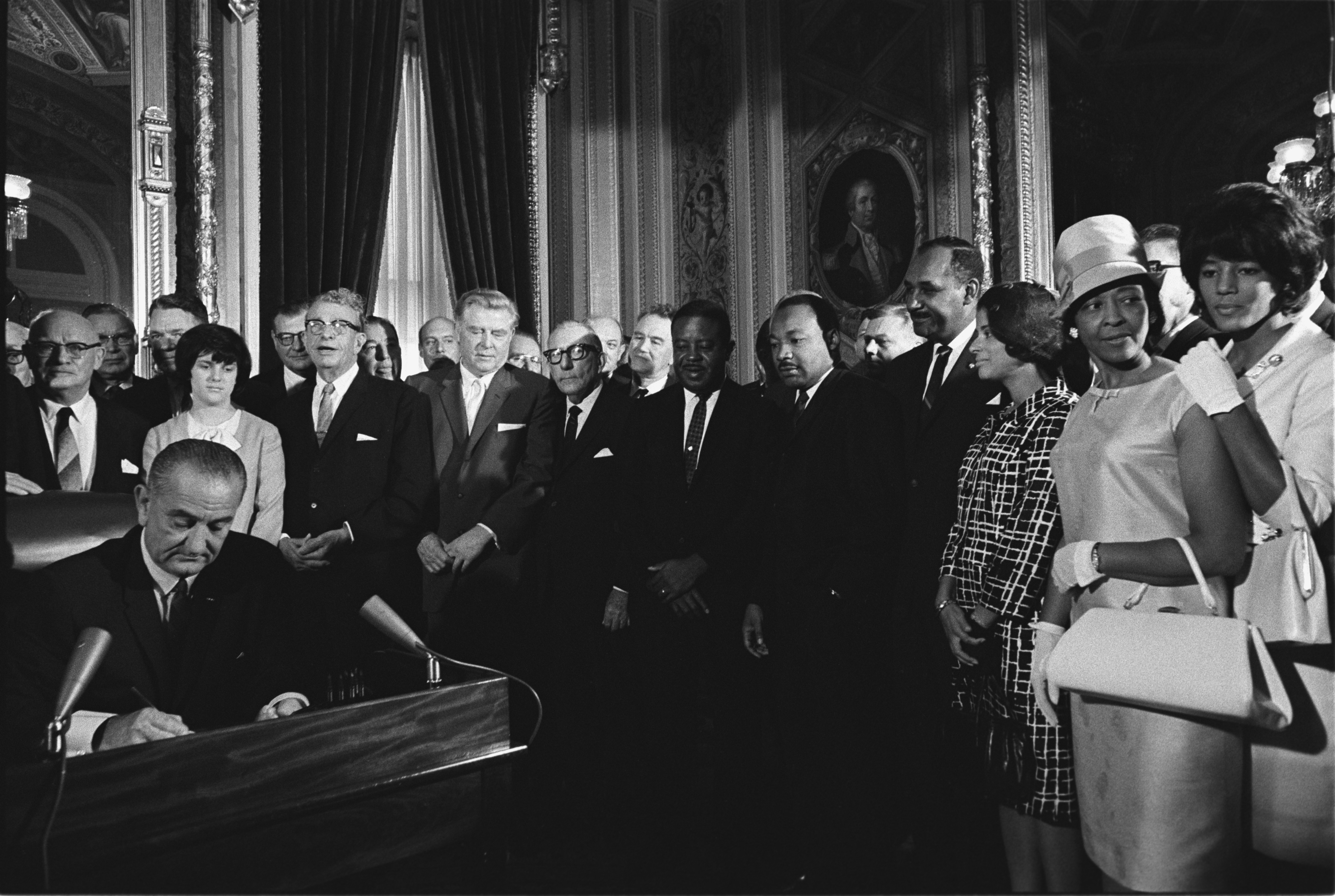Understanding Elections in U.S. History

Every election is consequential and determining who has the right to vote has been a struggle since the founding of the nation. Over the course of U.S. history, the stakes of some elections have been higher than others, especially in times of a national political, social, economic, or health crisis. Elections can also indicate the vitality of democracy itself, testing the structures of government as well as the public’s embrace of democratic principles. For those wanting to better understand this history, the American Social History Project/Center for Media and Learning has gathered a number of documents and teaching resources related to elections in the United States.
Some of the materials listed below describe the efforts of men and women to expand voting rights in order to realize the nation’s ideals of freedom and democracy, for example, the campaign to win women’s suffrage. The movement to secure voting rights for African American and Mexican American residents showed the bravery, tenacity and patriotism of activists. All of these voting rights campaigns also reveal persistent efforts to constrict the electorate in order to maintain white supremacy and keep political power in the hands of those with race and economic privilege.
Other materials focus specifically on past elections, highlighting moments when the media and political campaigns developed new ways to persuade voters or to forecast election outcomes.
Finally, given the contentious 2020 Supreme Court confirmation process, a section addresses the issue of Supreme Court nominations and how the composition of the Court became politicized by President Franklin D. Roosevelt in an attempt to advance the New Deal. At the bottom of the page, we share links to other digital archives and resources that examine these, and many other issues, in more depth.

Founding Debates on Suffrage
John Adams Argues for Limited Suffrage
In this 1776 letter, John Adams argues that women, children, and propertyless men should be excluded from voting in the new American republic.
The Struggle for Women’s Suffrage and the 19th Amendment
The struggle for women’s suffrage lasted almost a century, beginning with the 1848 Woman’s Rights Convention at Seneca Falls, New York. In 1876, activists who were disappointed that women were excluded from voting rights conferred by the 15th Amendment, called for a 16th Amendment that would grant voting rights to women. One activist, Chicago-born labor reformer and socialist Florence Kelley, supported women’s suffrage as a means to strengthen the political power of labor. In this selection from a speech to a 1898 national suffrage convention, Kelley urged that working women, particularly factory workers, needed the ballot to protect themselves from exploitation at the hands of their powerful employers.

In many states, women gained some voting rights even before the Nineteenth Amendment to the U.S. Constitution was ratified in 1920. This map shows states where women could vote before 1920.
More Logic, Less Feeling: Senator Vest Nixes Woman Suffrage
Throughout the 19th century, opposition to woman suffrage ran high. In an 1887 speech on the floor of the U.S. Senate, Democratic Senator George G. Vest of Missouri put forth traditional arguments that a woman’s proper place was at home, not the ballot box.
Which Women Should Vote? Harper Urges A Color-Blind Cause
The prolonged suffrage struggle entangled female activists in other important political and moral issues that divided the nation along racial, ethnic, and class lines. In this 1891 speech, African American abolitionist, lecturer, and writer Frances Ellen Watkins Harper argued that the vote for African Americans, both men and women, was a matter of “justice, simple justice.” Harper’s position was opposed by suffragists such as Belle Kearney, a white Mississippi activist. In this 1903 speech, Kearney advocated woman suffrage in order to suppress Black political power. Other white women argued that their votes could help lessen the political strength of immigrant communities. In 1894, for example, Carrie Chapman Catt rallied Iowa activists to support women’s suffrage as a way to counter “the ignorant foreign vote.”
Suffrage On Stage, the Page, and in Song
Woman suffrage campaigns sought to sway public opinion by imaginatively using art and media. Marie Jenney Howe wrote this Antisuffrage Monologue to parody anti-suffragist arguments that relied on stereotypes of female dependence, irrationality, and delicacy. Alice Duer Miller’s “Unauthorized Interviews” cleverly reversed gender stereotypes: the men were petulant and irrational, while the women suffragists remained cool and logical. “Der Sufferegetsky,” a Yiddish suffrage song, illustrates yet another medium used in the campaign for women’s enfranchisement. And suffragists defied gender norms and barnstormed the country, making rousing speeches from the back of cars, as Laura Seller recalled in this excerpt from an oral history interview.
Enfranchisement and Disenfranchisement for African Americans and Mexican Americans
Citizenship in Reconstruction America
This teaching unit from Investigating US History focuses on Reconstruction following the Civil War and addresses the importance of citizenship and the right to vote for formerly enslaved people. It includes links to primary documents and suggests classroom and writing assignments.
The Grandfather Clause in Louisiana
In the post-Reconstruction era, many states, north and south, passed voting restrictions — language requirements, registration laws, and literacy tests. In the South, these efforts intended to disempower African Americans and maintain Democratic party dominance; restrictions that barred voting on the basis of literacy or ownership of property also affected poor whites. This excerpt details a 1898 Louisiana law aimed specifically at African Americans.
Black Politicians Speak Out Against Disenfranchisement in South Carolina
In the 1880s and 1890s, South Carolina took many steps to disenfranchise African Americans (and many poor whites). In response, Black political leaders spoke in opposition at the 1895 state Constitutional Convention. Robert Smalls, formerly enslaved in South Carolina, later became a Congressman during Reconstruction. In this speech, Smalls reminded delegates of the many contributions that formerly enslaved men made to the state and called on his fellow political leaders to pass a Constitution that was fair, just, and honest. William J. Whipper also advocated for African American voting rights. A Northern black lawyer, Whipper moved to South Carolina during Reconstruction to become a rice planter as well as a Republican political leader.
Testimony from an African American Taxpayer Unable to Vote in Alabama
The 15th Amendment, ratified in 1870, guaranteed citizens the right to vote regardless of race. But by 1957, only 20 percent of eligible African Americans voted, due in part to intimidation and discriminatory state requirements such as poll taxes and literacy tests. In this testimony from a 1958 hearing, Hosea Guice of Macon County, Alabama described the roadblocks he encountered when trying to register to vote.
The American G.I. Forum Fights Disenfranchisement of Mexican Americans in Texas
The struggle of Mexican Americans to end voting restrictions and other discriminatory practices accelerated following World War II. In 1948, a group of Mexican American veterans formed an advocacy group, the American G.I. Forum, and began local “pay your poll tax” drives to register Tejano voters. In the following interview, Ed Idar, of the Forum, described how the persistent drive by the organization and its leader, Dr. Hector P. Garcia, increased the number of registered Mexican American voters.
A Call to Extend the Voting Rights Act of 1965
Following violent resistance to the civil rights movement, including an attack by state troopers to prevent a massive protest march in Selma, Alabama, President Lyndon B. Johnson pressed Congress to enact a voting rights bill with “teeth.” Passed in 1965, the Voting Rights Act applied to states or counties where fewer than half of the citizens of voting age were registered in 1964. In this letter, New Jersey Senator Harrison A. Williams, Jr., backed the law’s extension during 1969 Congressional hearings. At those hearings, Vernon E. Jordan strongly opposed changes to the law proposed by the Nixon Administration, arguing they would send "A Clear Signal to Officials of the White South: ’Go Back to Your Old Ways.’" Ultimately, President Nixon signed into law a bill that extended the Act’s provisions—including the requirement of federal oversight which the South found objectionable—and lowered the voting age throughout the country to 18.

Campaigns and Contested Elections
A Predicted Win Proved Wrong
The media, political parties, and even candidates themselves have relied on polls to attempt to predict election results; but what is the best way to measure public opinion? The magazine, Literary Digest, correctly forecast the outcomes of the 1916, 1920, 1924, 1928, and 1932 elections by conducting polls. This article in the Literary Digest's October 31, 1936 issue made a wildly incorrect prediction.
"Is Bryan Crazy?": The Times Makes a Diagnosis
The mental health of presidential candidates has long concerned the public. In 1896, psychiatrists—or alienists as they were called—became experts whose opinions were consulted regarding the sanity of Democratic presidential candidate William Jennings Bryan. After an anonymous “Alienist” declared in an op-ed that Bryan was of a “mind not entirely sound,” the New York Times followed up with an editorial that soberly endorsed the psychiatrist’s diagnosis.
“I Seen My Opportunities and I Took ’Em.”: An Old-Time Pol Preaches Honest Graft
George Washington Plunkitt was a well-known political boss in turn-of-the-century New York City. In 1905, journalist William Riordan published Plunkitt’s speeches in a book, which became a classic on American urban politics, one still widely read today. In this speech, Plunkitt balanced his political cynicism, with a defense of the virtues of hard work, sobriety, and even honesty—or “honest graft.”
The Supreme Court
The U.S. Supreme Court in the 1930s consistently opposed President Franklin Roosevelt’s New Deal programs. In May 1935, the Supreme Court, in the case of Schechter Poultry Corp. v. United States, invalidated the National Recovery Administration. The lengthy, unanimous opinion, excerpted here, demonstrated the U.S. Supreme Court’s complete unwillingness to endorse FDR’s argument that a national crisis demanded innovation.
“Younger and More Vigorous Blood”: FDR on the Judiciary
Frustrated by court decisions eliminating several New Deal programs, President Roosevelt proposed a novel but not entirely unprecedented solution in 1937. He would add one new judge to the federal judicial system for every active judge over the age of seventy, creating fifty new judgeships, including up to six new Supreme Court justices. The Court expansion bill would merely restore the balance of power intended by the Constitution’s framers, FDR argued in his March 9, 1937 fireside chat.
Pure Personal Government: Roosevelt Goes Too Far in Packing the Court
President Roosevelt’s 1937 attempt to expand the federal judiciary, known as his “Court-packing plan” by critics, was met with ferocious opposition. Popular columnists such as Dorothy Thompson from the Washington Star expressed disgust at Roosevelt’s plan to increase the number of Supreme Court justices and her objection to FDR’s continued popularity.

Other resources/non-ASHP that we’re finding useful and inspiring
Women and the American Story
A free curriculum website developed by the New-York Historical Society, with lessons and documents for educators interested in teaching about the experiences of women and their economic, political, and social contributions to the country.
The Long 19th Amendment Project
An initiative of the Schlesinger Library at Harvard’s Radcliffe Institute for Advanced Study, this project has gathered primary sources, teaching resources, and archival collections to promote new research, teaching, and learning about the history of gender and voting rights in America.
SNCC Digital Gateway
Timelines, primary source documents, personal testimonies and other materials that describe organizing campaigns for voting rights in the American South in the 1960s. The site focuses on activists in SNCC, the Student Nonviolent Coordinating Campaign, and emphasizes how this history can be a powerful tool for contemporary social change efforts.
Zinn Education Project
A multitude of free, downloadable teaching materials, including k-12 classroom activities and articles focused on presenting a “people’s history” of the United States.
Teaching About Voter Suppression and the 2020 Election
This collection of resources, compiled by Teaching Tolerance, teaches about the Voting Rights Act, the historic back-and-forth fight for voting rights, contemporary voter suppression and efforts to transform the democratic process.
